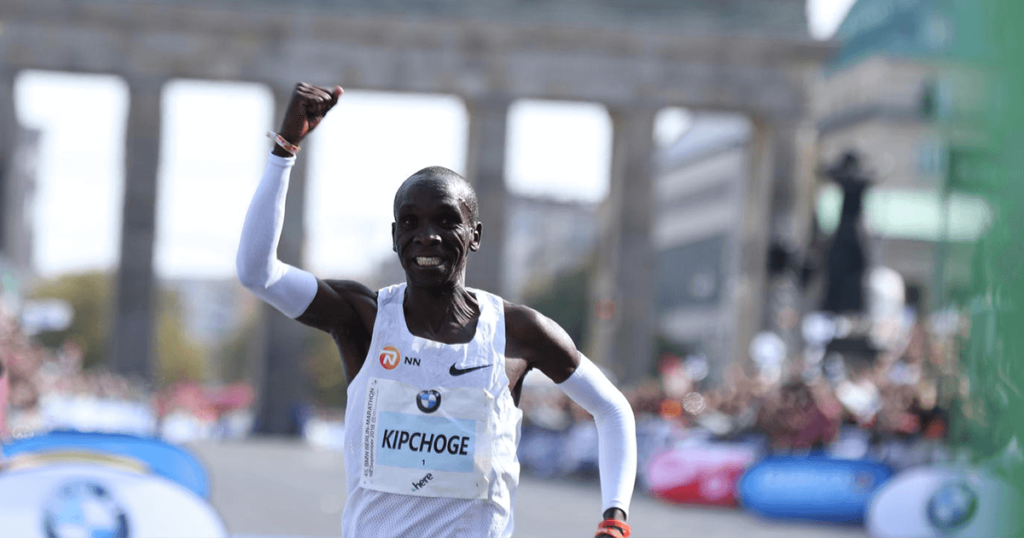Marathon Man
When it comes to athletic records, what was once thought impossible is now imaginable

Last weekend in Berlin, a 33-year-old Kenyan named Eliud Kipchoge set a new world record in the marathon, with a time of 2:01:39—a pace of 4:38 per mile. If you are not among the running cognoscenti, the transcendent nature of Kipchoge’s performance—78 seconds faster than the old record—may not be readily apparent. Suffice it to say that this was an athlete single-handedly launching his sport into a brave new realm. It was Babe Ruth ushering in baseball’s home run era, Martina Navratilova imposing her powerful serve-and-volley game on women’s tennis. Or, more to the point, Roger Bannister shattering preconceptions about the limits of human endurance when, in 1954, he became the first man to break four minutes in the mile.
Even before Berlin, the possibility of a sub-two-hour marathon had captured the collective sporting imagination, much as the quest for the sub-four-minute mile did in Bannister’s time. Long considered a test of endurance, the marathon—at least at the elite level—has suddenly become a test of sustained speed-endurance. It’s a subtle distinction, but the marathon just feels shorter, a point that Kipchoge hammered home in Berlin.
So how close are we to sub-two? And how close are we to reaching the limits of human potential? In 1991, Michael J. Joyner, now a professor of anesthesiology at the Mayo Clinic, published a paper in the Journal of Applied Physiology. Based on highly scientific measures—lactate threshold, running economy, VO2 max—Joyner made a very precise prediction about the absolute human limit in the marathon: 1:57:58.
Kipchoge’s performance is by far the biggest single leap forward to that anticipated limit in nearly half a century—one made possible in part by a Nike-sponsored program called Breaking2. In May 2017, after assembling a group of three elite runners (Kipchoge included), conducting extensive lab tests, and providing them with the latest in carbon-fiber-embedded shoe technology, experimental sports drinks, and aerodynamic uniforms and leg tape (no detail left unattended), Nike staged a marathon on a Formula 1 racetrack in Monza, Italy. For various reasons—mostly because a series of pacemakers were rotated in and out of the race after it had started, enabling the competitors to draft continuously—it didn’t qualify as an official record attempt. Still, Kipchoge nearly delivered on the event’s heady promise, running 2:00:25. But what would his time translate to in sanctioned conditions?
That remained unclear—until Berlin. Cynically, I had thought Breaking2 was nothing more than a savvy marketing ploy, an overhyped branding gimmick, but I now realize that it set the stage for Kipchoge’s record-breaking run. This past weekend, when he found himself alone in the later stages of the race, well clear of the field, Kipchoge knew he had maintained this kind of historic tempo before, knew he wasn’t confronting uncharted territory, and that confidence undoubtedly gave him a significant mental edge. As Kipchoge told a reporter before the Breaking2 race: “The difference only is thinking,” he said. “You think it’s impossible, I think it’s possible.”
In theory, such staggering leaps in athletic performance should happen less frequently as we get closer to our ultimate limits. How much more progress can still be made in shoe technology, in training programs, in nutrition? We seem to have reached a point of diminishing returns. After Kipchoge’s record, Joyner predicted that the sub-two-hour barrier will likely fall in the late 2020s or early 2030s. Which suggests that we are about to enter a period of incremental leaps—a few seconds here and there.
But consider this: Kipchoge’s pacemakers in Berlin dropped off much sooner than planned, leaving him to do a great deal of the work alone. Kipchoge, moreover, had something left at the finish: instead of collapsing to the ground, overcome with his effort, he ran past the finish line and leapt into the arms of his coach, overcome by the significance of his accomplishment. Indeed, scientists have only started to unravel the mind-body connection and its impact on athletic performance. Kipchoge, with his sublime and graceful effort, reminded us that there’s still room for big dreams.

